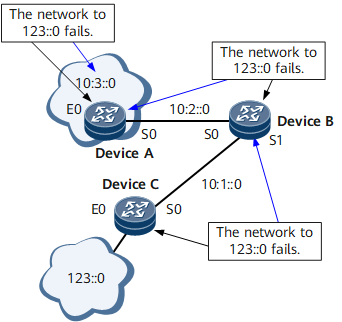Triggered Update
Triggered update allows a device to advertise the routing information changes immediately, which speeds up network convergence.
In Figure 1, if network 123::0 is unreachable, DeviceC learns the information first. By default, a RIPng-enabled device sends Update packets to its neighbors every 30 seconds. If DeviceC receives an Update packet from DeviceB within 30s when DeviceC is still waiting to send Update packets, DeviceC learns the incorrect route to 123::0. In this case, the next hops of the routes from DeviceB and DeviceC to 123::0 are DeviceC andDeviceB, respectively, which results in routing loops. If DeviceC sends an Update packet to DeviceB immediately after it detects a network fault, DeviceB can rapidly update its routing table, which prevents routing loops.
In addition, if the next hop of a route becomes unavailable due to a link failure, the local Router sets the cost of the route to 16 and then advertises the route immediately to its neighbors. This process is called route poisoning.
